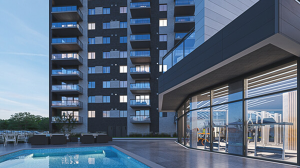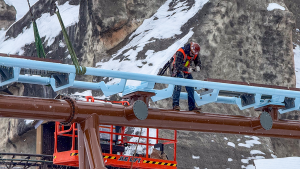Canada’s post-war multi-unit residential buildings (MURBs) have a big heating problem.
In many of the rental residences, units are heated by hot-water radiators with, in many cases, no functioning control mechanisms because on-off valves long ago seized up.
There were usually no thermostats installed in that era so if tenants are too cold or hot they call the landlord who in winter invariably ends up heating all units to meet the needs of the chilliest person.
That’s why, on a visit to a Toronto Community Housing building last January with temperatures of possibly -25 C, University of Toronto post-doctoral researcher Jamie Fine took note that many units had windows wide open as tenants tried to beat the heat.
The costs to the landlord of paying for the wasted natural gas or electricity that powers the heating system, the discomfort of the tenants and the environmental costs are all lamentable, Fine says — but he’s working on a solution.
His current project, titled A Crowd-Sourced Control Strategy for the Retrofit of Post-War Multi-Unit Residential Building Heating Systems, was recently awarded $45,000 in funding by Canada Mortgage and Housing Corporation (CMHC) and the Natural Sciences and Engineering Research Council of Canada.
“We have done a case study and shown it is a viable and potentially practical strategy,” Fine said in an interview. “I have faith in the energy model that we built. It had surprisingly good results.”
One proposed solution to the lack of temperature controls in each unit is to retrofit each one with a thermostatic valve.
But Fine determined that at a quoted cost of $825 to $1,400 per valve, that strategy is cost-prohibitive for mass adoption.

Searching for a less expensive solution, a crowd-sourced control strategy that allows occupants to use smartphones or other methods to register their level of temperature comfort was devised. The approach allows for temperature control to be grouped, thus reducing the number of valves required for the retrofit.
“If we group units together, we reduce the capital cost and combine all of those votes and using these combined votes you can control one value. Now it is not the chilliest person in a building but it is the chilliest person in a group that determines the level of heat,” Fine explained.
Fine embarked on his research at the U of T last September after receiving a PhD in August from Ryerson.
Field data was collected from a case study building in Toronto and a 320-suite simulation model was developed. Using the crowd-sourcing tool, Fine was able to assemble grouping options that include exposure direction, suite floorplan and combinations of floors.
He determined the optimal grouping was when five floors were combined in each group and a north-south exposure split implemented.
The number of control valves required was eight — a significant drop from 320.
Payback analysis was also conducted, comparing the crow-sourced-derived groupings with the one-valve-per-unit model. Fine’s model delivered a 17 per cent reduction in space heating energy consumption, an 82 per cent reduction in overheating and a payback period that has been calculated at 10 years.
Installing one valve per suite resulted in a 26 per cent reduction in space heating energy consumption, a 93 per cent reduction in overheating, and a payback period of 27 years.
The findings, Fine said, demonstrate that the crowd-sourced method can be an effective strategy in improving the performance of post-war MURBs.
“When we did our analysis of the payback, we were targeting 10 years, that is an acceptable number from what we have heard from building owners,” he said. “And the typical lifespan of equipment is 20 years. So you are well within the typical equipment lifespan, which is good.”
Fine has already considered installing a wireless temperature sensor in each unit instead of relying on humans. But each sensor costs $50 which adds up to a major expense, he said.
Benefits accrue at many levels, he said, with the important gain being reduced overheating.
The building owners reap cost savings through reduced heating bills and capital savings by only paying for a handful of new control valves.
And from an environmental standpoint, Fine said, “When you use less energy to heat a building you save CO2.”
Fine’s research is focused on the 1,200 post-war towers in southern Ontario built between 1960 and 1970. His strategy requires buildings with a riser layout, with boilers on the roof or in the basement and pipes delivering heat.
Fine’s postdoctoral fellowship grant was one of eight bestowed in July by the CMHC as part of the federal National Housing Strategy Housing Research Scholarship Program.
Got comments? Follow the writer at @DonWall_DCN.








Recent Comments
comments for this post are closed